A blueprint can show a building. 3D exterior rendering software shows how it lives—how sunlight will warm its facade, how it will command a landscape, or nestle into an urban streetscape. This is the art of exterior visualization: crafting an entire atmosphere to sell a vision before ground is ever broken. But with countless platforms available, which one truly delivers? We've cut through the noise to analyze the eight best 3D exterior rendering software solutions for 2025. This is your definitive guide to finding the right tool to bring your architectural vision to life.
Why Your Choice of Exterior Renderer is a Strategic Decision
Let's be honest: your choice of exterior rendering software isn't about pixels. It's about persuasion. It’s the silent partner in the room that closes deals, wins over skeptical planning committees, and sells multi-million dollar properties before a single shovel hits the dirt.
Think of it this way: every render you create is an argument. It's an argument for your design's harmony with its surroundings, for its sustainability through detailed shadow studies, for its sheer emotional impact on a potential buyer. A client might not understand a complex site plan, but they will feel the warmth of an afternoon sun rendered perfectly on a terrace.
When the stakes are this high, your renderer is far more than a production tool. It’s a strategic asset. The platforms below have been chosen not just for their power, but for their ability to craft these convincing arguments, each with a unique approach to solving the complex puzzle of exterior visualization.
The 8 Best 3D Exterior Rendering Software for 2025
Our analysis focuses on platforms that offer specialized workflows, extensive environmental libraries, and features designed specifically for the demands of outdoor scene visualization.
1. Realishot - The Cloud-Native Hub for Collaborative Design
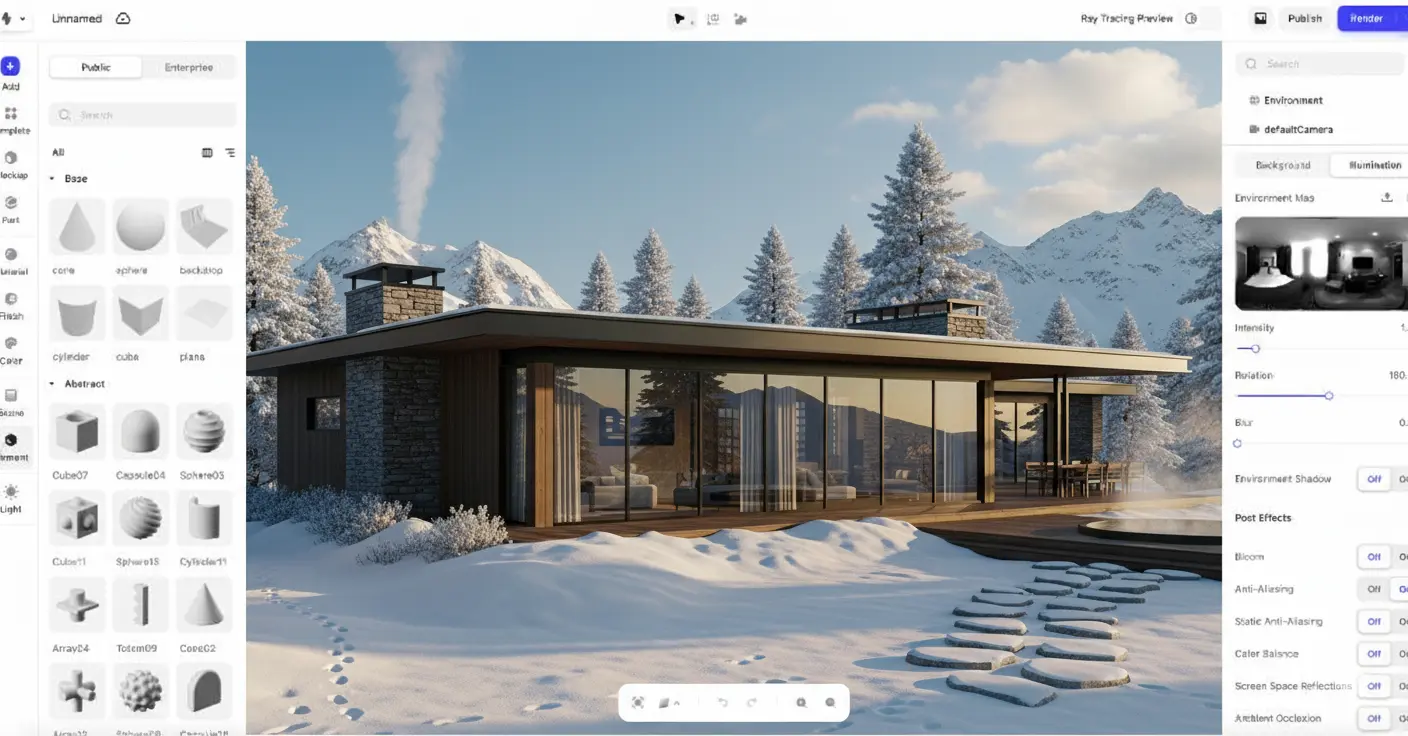 Realishot Exterior 3D Rendering
Realishot Exterior 3D Rendering
While traditional software focuses on raw rendering power on a single machine, Realishot redefines the entire workflow by moving it to the cloud. It's built to solve the modern challenges of collaboration, asset management, and accessibility that plague most design firms.
 Core Strength: A unified, browser-based ecosystem. Realishot acts as a centralized hub for your team's 3D assets, ensuring brand consistency across projects. Its power lies in real-time data collaboration, allowing multiple designers to co-edit scenes and clients to review photorealistic updates via a simple web link, eliminating endless file transfers and versioning chaos.
Core Strength: A unified, browser-based ecosystem. Realishot acts as a centralized hub for your team's 3D assets, ensuring brand consistency across projects. Its power lies in real-time data collaboration, allowing multiple designers to co-edit scenes and clients to review photorealistic updates via a simple web link, eliminating endless file transfers and versioning chaos. Workflow: Entirely browser-based. This eliminates hardware bottlenecks, costly software installations, and OS compatibility issues. You can manage a massive landscape project and kick off a dozen renders from a MacBook Air while your heavy-lifting is handled by scalable cloud infrastructure.
Workflow: Entirely browser-based. This eliminates hardware bottlenecks, costly software installations, and OS compatibility issues. You can manage a massive landscape project and kick off a dozen renders from a MacBook Air while your heavy-lifting is handled by scalable cloud infrastructure. Best For: Distributed architectural firms, real estate developers managing large portfolios, and any team that prioritizes a seamless, collaborative client-review process over a siloed, desktop-based workflow.
Best For: Distributed architectural firms, real estate developers managing large portfolios, and any team that prioritizes a seamless, collaborative client-review process over a siloed, desktop-based workflow. Investment: A flexible subscription model (starting at $29/month) that provides a high ROI by drastically reducing hardware dependency and streamlining team productivity.
Investment: A flexible subscription model (starting at $29/month) that provides a high ROI by drastically reducing hardware dependency and streamlining team productivity.
2. Lumion - The Dedicated Exterior Visualization Leader
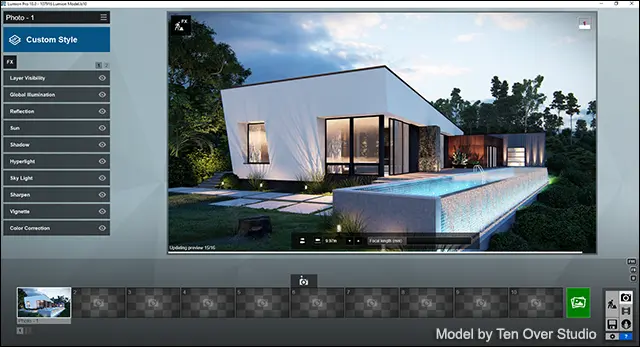 Lumion UI
Lumion UI
Lumion has built its reputation by focusing almost exclusively on the needs of architectural and exterior visualization, making it a go-to for designers who need to produce stunning outdoor scenes quickly on the desktop.
 Core Strength: Its massive, high-quality library of landscape assets (trees, plants, people), coupled with intuitive weather and time-of-day systems, allows for rapid creation of rich, living environments.
Core Strength: Its massive, high-quality library of landscape assets (trees, plants, people), coupled with intuitive weather and time-of-day systems, allows for rapid creation of rich, living environments. Workflow: Known for its seamless integration with major CAD and modeling software (like SketchUp, Revit, and ArchiCAD), allowing for a fast and iterative workflow.
Workflow: Known for its seamless integration with major CAD and modeling software (like SketchUp, Revit, and ArchiCAD), allowing for a fast and iterative workflow. Best For: Architects and firms specializing in large-scale developments who need to produce high-quality animations and stills with a fast turnaround.
Best For: Architects and firms specializing in large-scale developments who need to produce high-quality animations and stills with a fast turnaround. Investment: A professional-grade tool with a corresponding license cost, valued for its speed and extensive content library.
Investment: A professional-grade tool with a corresponding license cost, valued for its speed and extensive content library.
3. D5 Render - The Real-Time Ray Tracing Powerhouse
D5 Render is a game-changer, merging the instant feedback of a real-time engine with the stunning quality of path-traced rendering. It's rapidly becoming a favorite for its balance of quality and speed.
%20(1)%20(1)-7xggl6.webp) D5 Render
D5 Render
 Core Strength: Real-time ray tracing. D5 allows you to sculpt your scene with photorealistic lighting and reflections enabled, providing immediate, high-fidelity feedback. Its vegetation and sky systems are also top-tier.
Core Strength: Real-time ray tracing. D5 allows you to sculpt your scene with photorealistic lighting and reflections enabled, providing immediate, high-fidelity feedback. Its vegetation and sky systems are also top-tier. Workflow: Offers a clean, modern interface and excellent performance, especially on modern RTX graphics cards. AI-enhanced features, like automatic sky replacement, further streamline the process.
Workflow: Offers a clean, modern interface and excellent performance, especially on modern RTX graphics cards. AI-enhanced features, like automatic sky replacement, further streamline the process. Best For: Designers who demand photorealistic quality without sacrificing the speed and interactivity of a real-time workflow.
Best For: Designers who demand photorealistic quality without sacrificing the speed and interactivity of a real-time workflow. Accessibility: Offers a generous free version, with a professional subscription unlocking advanced features, making it highly accessible.
Accessibility: Offers a generous free version, with a professional subscription unlocking advanced features, making it highly accessible.
4. Twinmotion - Unreal Engine's Cinematic Excellence
Leveraging the power of Epic Games' Unreal Engine, Twinmotion delivers cinematic-quality real-time visualization with a focus on user-friendliness and exceptional environmental realism.
-5z0zko.webp) Twinmotion UI
Twinmotion UI
 Core Strength: Its Path Tracer produces some of the most photorealistic stills and animations in the real-time space. The weather, vegetation, and water systems are deeply integrated and capable of creating incredibly immersive atmospheres.
Core Strength: Its Path Tracer produces some of the most photorealistic stills and animations in the real-time space. The weather, vegetation, and water systems are deeply integrated and capable of creating incredibly immersive atmospheres. Workflow: The Datasmith tool ensures a robust and reliable connection to virtually all major architectural design software, making it a seamless part of any professional pipeline.
Workflow: The Datasmith tool ensures a robust and reliable connection to virtually all major architectural design software, making it a seamless part of any professional pipeline. Best For: Firms that want to produce high-end, cinematic presentations, including VR walkthroughs, and value the power of a world-class game engine.
Best For: Firms that want to produce high-end, cinematic presentations, including VR walkthroughs, and value the power of a world-class game engine. Accessibility: Very accessible, with a free version for many users and competitive pricing for commercial licenses.
Accessibility: Very accessible, with a free version for many users and competitive pricing for commercial licenses.
5. Chaos V-Ray - The Industry Standard for Photorealism
-8e44cw.webp) V-Ray UI
V-Ray UI
For decades, V-Ray has been the benchmark for photorealistic rendering. It's a powerful, versatile, and reliable engine trusted by top-tier firms for projects where absolute realism is non-negotiable.
 Core Strength: Physically accurate lighting and materials. V-Ray's algorithms for calculating global illumination are legendary, producing exceptionally realistic results for complex exterior lighting scenarios.
Core Strength: Physically accurate lighting and materials. V-Ray's algorithms for calculating global illumination are legendary, producing exceptionally realistic results for complex exterior lighting scenarios. Workflow: Integrates as a plugin into most major 3D applications (3ds Max, SketchUp, Rhino), allowing designers to work within their familiar environment.
Workflow: Integrates as a plugin into most major 3D applications (3ds Max, SketchUp, Rhino), allowing designers to work within their familiar environment. Best For: High-end architectural visualization studios and professionals who require the utmost control and physical accuracy for their final renders.
Best For: High-end architectural visualization studios and professionals who require the utmost control and physical accuracy for their final renders. Platform Integration: Its broad support across different host applications makes it a flexible choice for firms with diverse software pipelines.
Platform Integration: Its broad support across different host applications makes it a flexible choice for firms with diverse software pipelines.
6. Enscape - The Live-Linked Real-Time Engine
Enscape's genius lies in its deep, seamless integration directly within your primary design software. It’s less a separate program and more a live, photorealistic window into your model as you build it, transforming rendering from a final step into an integral part of the design process itself.
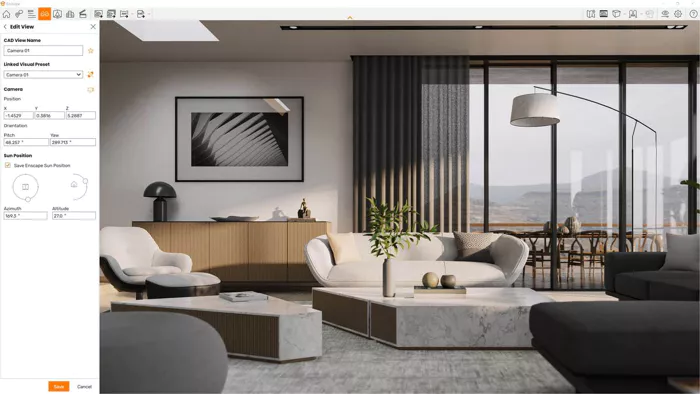 enscape-suaxp5.webp
enscape-suaxp5.webp
 Core Strength: Its unparalleled real-time link. The ability to walk through a photorealistic version of your project in Enscape while simultaneously making changes in Revit, SketchUp, or ArchiCAD is a workflow revolution.
Core Strength: Its unparalleled real-time link. The ability to walk through a photorealistic version of your project in Enscape while simultaneously making changes in Revit, SketchUp, or ArchiCAD is a workflow revolution. Workflow: Operates as a simple plugin. This creates an incredibly fluid, iterative design loop where visual feedback is instant, allowing for on-the-fly design decisions with full environmental context.
Workflow: Operates as a simple plugin. This creates an incredibly fluid, iterative design loop where visual feedback is instant, allowing for on-the-fly design decisions with full environmental context. Best For: Architects and designers working heavily within BIM or CAD environments who prioritize speed and want to integrate high-quality visualization directly into their day-to-day modeling tasks.
Best For: Architects and designers working heavily within BIM or CAD environments who prioritize speed and want to integrate high-quality visualization directly into their day-to-day modeling tasks. Investment: A professional subscription-based tool whose ROI is measured in the immense time saved during the design and revision phases.
Investment: A professional subscription-based tool whose ROI is measured in the immense time saved during the design and revision phases.
7. Chaos Corona - The Artist-Friendly Photorealism Engine
Originally born as Corona Renderer, this Chaos powerhouse is legendary for making high-end photorealism artist-friendly and accessible. While celebrated for its interior shots, its integration with Chaos assets makes it a formidable tool for beautiful, naturalistic exteriors.
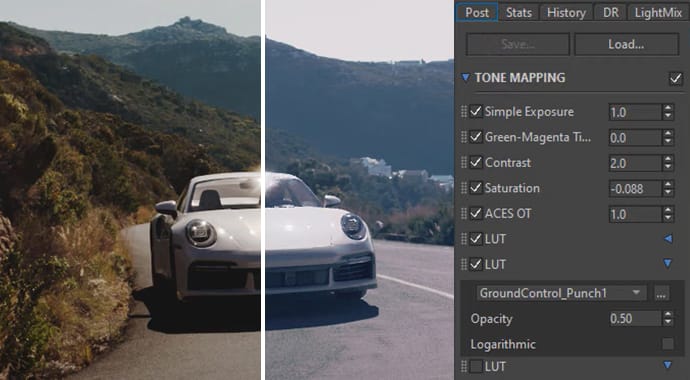 Corona
Corona
 Core Strength: The balance of simplicity and stunning results. Corona requires significantly fewer technical adjustments than other offline renderers to achieve a clean, physically accurate image. The inclusion of the Chaos Cosmos library and Chaos Scatter tool is a massive boon for creating dense, believable landscapes.
Core Strength: The balance of simplicity and stunning results. Corona requires significantly fewer technical adjustments than other offline renderers to achieve a clean, physically accurate image. The inclusion of the Chaos Cosmos library and Chaos Scatter tool is a massive boon for creating dense, believable landscapes. Workflow: Integrates beautifully with 3ds Max and Cinema 4D. Its standout feature, LightMix, allows for dramatic lighting changes after the render is complete, offering incredible creative flexibility and saving countless hours of re-rendering.
Workflow: Integrates beautifully with 3ds Max and Cinema 4D. Its standout feature, LightMix, allows for dramatic lighting changes after the render is complete, offering incredible creative flexibility and saving countless hours of re-rendering. Best For: Studios and artists using 3ds Max or C4D who desire V-Ray-level quality without the intimidating learning curve. It's a perfect choice for projects demanding both premium interiors and exteriors.
Best For: Studios and artists using 3ds Max or C4D who desire V-Ray-level quality without the intimidating learning curve. It's a perfect choice for projects demanding both premium interiors and exteriors. Investment: Part of the Chaos subscription ecosystem, offering exceptional value, especially when bundled with V-Ray.
Investment: Part of the Chaos subscription ecosystem, offering exceptional value, especially when bundled with V-Ray.
8. Blender - The Ultimate Open-Source Ecosystem
Blender is more than just a free program; it's a universe of creative potential. While its out-of-the-box tools are powerful, its true strength in exterior rendering is unlocked through its vibrant, ever-expanding ecosystem of third-party addons.
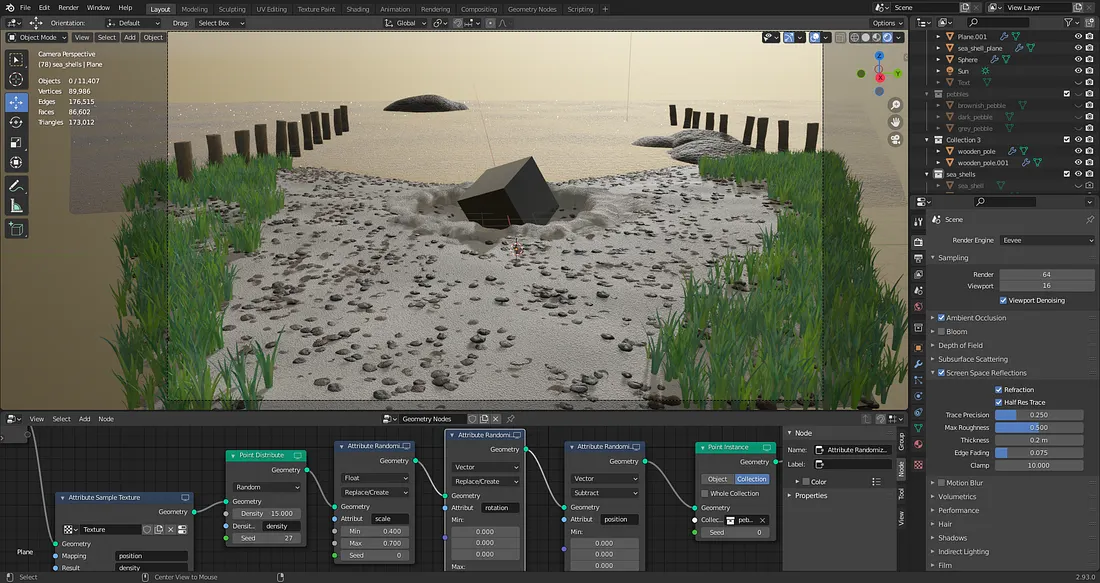 blender-ui-9ohfwb.webp
blender-ui-9ohfwb.webp
 Core Strength: Limitless customization at zero software cost. Using its phenomenal Cycles render engine as a base, you can build a world-class exterior pipeline with addons for atmospheric effects (Physical Starlight and Atmosphere), vegetation scattering (Scatter 5), and vast plant libraries (Botaniq, Graswald).
Core Strength: Limitless customization at zero software cost. Using its phenomenal Cycles render engine as a base, you can build a world-class exterior pipeline with addons for atmospheric effects (Physical Starlight and Atmosphere), vegetation scattering (Scatter 5), and vast plant libraries (Botaniq, Graswald). Workflow: A modular, "build-your-own" approach. This requires an investment of time to research, install, and master different addons, but the result is a toolset perfectly tailored to your specific needs.
Workflow: A modular, "build-your-own" approach. This requires an investment of time to research, install, and master different addons, but the result is a toolset perfectly tailored to your specific needs. Best For: Freelancers, small studios on a tight budget, and technical artists who relish the freedom to customize their tools and are willing to trade a steeper learning curve for unparalleled creative control.
Best For: Freelancers, small studios on a tight budget, and technical artists who relish the freedom to customize their tools and are willing to trade a steeper learning curve for unparalleled creative control. Accessibility: The software is completely free. The only costs are time and any premium addons you choose to purchase, which are still a fraction of the price of commercial licenses.
Accessibility: The software is completely free. The only costs are time and any premium addons you choose to purchase, which are still a fraction of the price of commercial licenses.
Buyer's Guide: How to Evaluate Exterior Rendering Software
Beyond the brand names, your decision should be guided by your firm's philosophy of work. Understanding these core pillars is crucial for making a truly strategic investment.
1. Environmental Simulation and Weather Effects
This is the baseline for realism. A platform's ability to simulate the natural world is what separates a simple model from a convincing environmental story.
 Dynamic Weather: Look for realistic rain, snow, and wind that dynamically affects vegetation. A living world is more persuasive than a static one.
Dynamic Weather: Look for realistic rain, snow, and wind that dynamically affects vegetation. A living world is more persuasive than a static one. Advanced Lighting: Go beyond a simple sun. Demand procedural skies, geographically accurate solar studies, and flawless HDRI mapping for nuanced, physically-based lighting.
Advanced Lighting: Go beyond a simple sun. Demand procedural skies, geographically accurate solar studies, and flawless HDRI mapping for nuanced, physically-based lighting. Atmospheric Effects: The subtle arts of fog, haze, and atmospheric perspective are what create a true sense of depth and scale, turning a large scene from a flat image into an immersive vista.
Atmospheric Effects: The subtle arts of fog, haze, and atmospheric perspective are what create a true sense of depth and scale, turning a large scene from a flat image into an immersive vista.
2. Landscape and Vegetation Realism
An exterior render is often only as believable as its greenery. This is a non-negotiable area where quality and variety are paramount.
 Asset Libraries: A vast, high-quality library isn't a luxury; it's a necessity. Prioritize platforms with diverse, regional plant species, seasonal variations, and realistic growth stages.
Asset Libraries: A vast, high-quality library isn't a luxury; it's a necessity. Prioritize platforms with diverse, regional plant species, seasonal variations, and realistic growth stages. Rendering Technology: The best systems use advanced tech like subsurface scattering (for that translucent, sun-through-the-leaf look), wind animation, and efficient instancing to render millions of plants without crippling your machine.
Rendering Technology: The best systems use advanced tech like subsurface scattering (for that translucent, sun-through-the-leaf look), wind animation, and efficient instancing to render millions of plants without crippling your machine. Terrain & Water: Your tool must handle the earth itself. Look for accurate topography import, intuitive sculpting tools, and water simulation that convincingly renders everything from a tranquil pool to a flowing river.
Terrain & Water: Your tool must handle the earth itself. Look for accurate topography import, intuitive sculpting tools, and water simulation that convincingly renders everything from a tranquil pool to a flowing river.
3. The Collaboration Engine: Moving from Silos to Studios
This is the most critical, and often overlooked, evaluation point. How does the software enable your team to work together? The traditional workflow is a digital silo: one artist on one powerful machine, exporting endless files for review. This model is broken.

The Old Way (File-Based): This involves packaging massive files, uploading them, sending links, and deciphering feedback from a dozen scattered email threads. It's slow, prone to error, and fundamentally isolating.

The New Way (Cloud-Native): The future is a centralized, living project. This is where Realishot establishes its core advantage. Instead of sending files, you share a link. The project becomes a collaborative workspace. Try Now

Real-Time Co-Editing: Your team can work on the same scene simultaneously.
 Centralized 3D Asset Management: Your firm’s entire library of plants, materials, and models lives in one place, ensuring consistency.
Centralized 3D Asset Management: Your firm’s entire library of plants, materials, and models lives in one place, ensuring consistency. Instant Client Reviews: Clients can orbit, inspect, and leave feedback directly on the 3D model in their browser, with no software to install.
Instant Client Reviews: Clients can orbit, inspect, and leave feedback directly on the 3D model in their browser, with no software to install.
When you evaluate software, don't just ask "How fast does it render?" Ask "How fast does it get my team to an approved design?"
ROI Analysis: The Value of Investing in a Modern Workflow
A strategic investment in professional exterior visualization delivers measurable returns, especially when you factor in the power of collaboration.
 Client Acquisition: High-quality renderings dramatically improve competition win rates. This effect is amplified when you can offer clients a transparent, interactive review process—a powerful differentiator that builds trust from day one.
Client Acquisition: High-quality renderings dramatically improve competition win rates. This effect is amplified when you can offer clients a transparent, interactive review process—a powerful differentiator that builds trust from day one. Operational Efficiency: Clear visualizations accelerate approvals and reduce revisions. This is supercharged by cloud platforms like Realishot, where feedback is instant and centralized, slashing the traditional revision cycle from days to hours.
Operational Efficiency: Clear visualizations accelerate approvals and reduce revisions. This is supercharged by cloud platforms like Realishot, where feedback is instant and centralized, slashing the traditional revision cycle from days to hours. Market Positioning: Demonstrating expertise with cutting-edge tools establishes your firm as a technology leader. Offering a seamless, cloud-based client portal isn't just a feature; it's a statement about your firm's modern, efficient, and client-focused approach.
Market Positioning: Demonstrating expertise with cutting-edge tools establishes your firm as a technology leader. Offering a seamless, cloud-based client portal isn't just a feature; it's a statement about your firm's modern, efficient, and client-focused approach.
Conclusion: Mastering the Art of the Environment
The evolution of 3D exterior rendering software has given us incredible power. Specialized desktop platforms like Lumion and D5 Render offer breathtaking speed and realism, while industry standards like V-Ray guarantee uncompromising quality.
But the most profound transformation isn't just in the pixels; it's in the process. The strategic question for today's design firm is no longer just if you should adopt this technology, but how it will integrate with your team. Do you continue to invest in the solitary power of the desktop, or do you embrace the multiplied force of a connected, collaborative studio?
Cloud-based innovators like Realishot are making a compelling case that the future of design is accessible, iterative, and inherently collaborative. Success now hinges not only on making clients see a space, but on inviting them into the creative process. By choosing a tool that champions this philosophy, you gain a decisive competitive advantage, build stronger client relationships, and ultimately, create better designs, together.
Ready to transform your environmental design practice? Start your free Realishot trial today and discover the power of collaborative, cloud-based landscape rendering.
Referrence:
